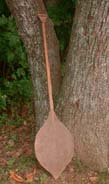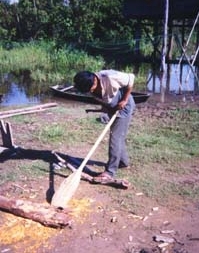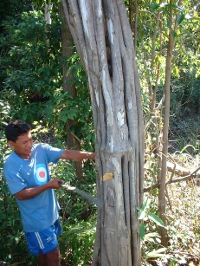The collector looked at my dugout canoe paddles. “Those are too new,” he said, “I want the real stuff–-old paddles that have been repaired along the river.”
I dug thorough my collection and found just what he wanted, an ancient tulip-shaped paddle that someone had repaired with the split open case of a flashlight battery.
“I’ll take it,” he said, “and that one over there with the mud on it.”
This collector knew his business; he was looking for more than something just to hang on his wall. He was looking for a paddle that told a story—how a paddle was jammed into the river bank to moor a canoe or how a fisherman made a quick repair to get on with the day’s work.
I search along the creeks in eastern Peru for dugout canoe paddles. I look for paddles that are fairly broad and shaved thin. I also look for a few busted ones for collectors
Legend has it that dugout out canoe paddles have a tulip shape to better sweep out water in a swamped canoe. I’ve tried it, but cupped hands seem to do just as well.
I find very little differences in paddle designs as I visit different villages. Most design differences are due to the whims of the craftsmen. The tulip-shaped design seems to be universal throughout the jungle and indeed through out the world. Maybe it’s a hydrodynamic question that speaks to the greatest amount of thrust for the least amount of turbulence. Turbulence makes noise that scares away fish.
I do know that native people treat paddle sizes like gear ratios. They use small paddles when they want to paddle fast and broad paddles when they want slow, strong strokes—a little like gears on a bicycle.
The wood of choice for paddles is remo caspi (paddle wood) Aspidosperma excelsum. Common wisdom says the craftsmen cut the paddles from the buttress roots of the tree. I see plenty of A. excelsum in the sawmills around Iquitos, but none large enough to cut a paddle from. A. excelsum is also used for building beams and has the unique look of muscles and sinew of an arm. With A. excelsum disappearing, paddle craftsmen use any wood available. I’ve even seen paddles made from caoba the fine Amazonian Mahogany, Swietenia macrophylla, but most settle for planks of catahua, Hura crepitans or even cumala, Virola calophylla. The latter is a poor-quality wood lasting only a few months before the jungle has it’s way with it.
With A. excelsum disappearing, paddle craftsmen use any wood available. I’ve even seen paddles made from caoba the fine Amazonian Mahogany, Swietenia macrophylla, but most settle for planks of catahua, Hura crepitans or even cumala, Virola calophylla. The latter is a poor-quality wood lasting only a few months before the jungle has it’s way with it.
I can ship paddles by parcel post from here in Peru as long as they are under 5 feet long. Anything longer must go into a crate then by freighter to Houston. If you are interested in dugout canoe paddles visit my website at http://www.biobio.com for pricing and shipping information.
